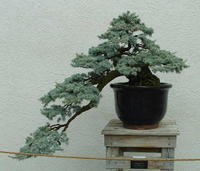Inspiration Part II
This tree, at the entrance to the Japanese pavillion, is a 200-year old Japanese red pine (Pinus densiflora) in the slanting style.
So, part two of Inspiration at the Arboretum will concentrate on the beautiful little trees at the National Arboretum. The trees at the arboretum comprise the National Bonsai and Penjing Museum, the largest of it's kind in North America. The collection was started with a gift of 57 bonsai from the Japanese imperial family to the United States on the occasion of our bicentennial. It has since had many additions, and has seperate sections for Japanese, Chinese, North American, and tropical Bonsai.
Bonsai is the art of growing trees in pots or trays, with an emphasis on keeping trees in miniature through careful training and pruning (of both branches and roots). The emphasis is on creating an aesthetic shape and the illusion of age.
We've all heard of Bonsai, but what about Penjing? Well, Penjing came first, and is in fact, the Chinese version of Bonsai. The only significant difference, so far as I know, is that Bonsai tends to concentrate on the appearance of great age in a specimen that is not neccesarily old, and is much smaller than it probably would be under natural conditions, while Penjing concentrates more on creating a miniature landscape including these trees.
Why do I love Bonsai? Well, Bonsai is a neat mix of horticulture and art. It appeals to me because I love small plants and intricate, artistic detail. The only thing I do that comes close in my gardening is attempting to create miniature alpine landscapes in my troughs. Bonsai requires a great deal of time and patience, neither of which I have in great supply. Anyway, on with the show...









Well, that about does it for me. If you'd like to see more, USNA has a virtual tour with some nice pictures and a lot of information on their webpage. The website bonsaisite.com has a lot more information as well.


